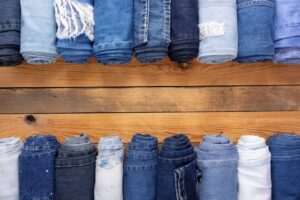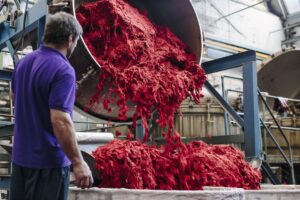Why Jewelry Choices Matter
Jewelry is meant to symbolize beauty, love, and permanence — yet much of today’s jewelry is anything but permanent. Behind the sparkle, there are hidden costs: destructive mining, unsafe labor, animal exploitation, and disposable production that feeds a growing “fast jewelry” culture.
But there’s good news. Jewelry can shine ethically if you know what to look for. Choosing pieces that respect people, animals, and the planet ensures your sparkle is guilt-free and meaningful.
The Problem with Fast Jewelry
Fast jewelry is the accessory equivalent of fast fashion: mass-produced, cheap, trendy, and designed to break or tarnish quickly. It may look glamorous online or in stores, but the real cost is staggering.
- Environmental harm: Many fast jewelry pieces are made from low-quality alloys that degrade quickly and end up in landfills. They often contain plastics, toxic coatings, or heavy metals that leach into soil and waterways.
- Labor exploitation: Cheap prices are possible because workers, often in countries with weak labor protections, are underpaid and face unsafe conditions.
- Disposable culture: Just like fast fashion, fast jewelry is marketed to be worn for a season, then tossed when it tarnishes or trends change. Millions of tons of discarded accessories contribute to global waste each year.
- Animal exploitation: Shells, coral, pearls, and exotic leathers are sometimes used without concern for ecosystems or animal welfare.
Fast jewelry turns what should be a cherished keepsake into a single-use accessory. Shifting away from this mindset is the first step toward a jewelry industry that actually cares.
People: Ethical Labor and Transparency
When jewelry claims to be “ethical,” always look beyond the marketing.
- Fair Labor Practices: Look for certifications like Fair Trade or Responsible Jewellery Council (RJC). Brands that publish factory audits, disclose supply chains, or show photos of artisans are usually more trustworthy.
- Safe Working Conditions: Ethical brands invest in safe workplaces, fair wages, and training for artisans rather than cutting costs at workers’ expense.
- Community Support: Some brands go further by funding schools, supporting healthcare, or reinvesting in artisan communities.
Ask: Who made this jewelry, and under what conditions? If the brand can’t answer, think twice.
Animals: Cruelty-Free Materials
The jewelry industry has a history of using materials that exploit animals or harm ecosystems. Conscious shoppers can make kinder choices.
- Avoid coral, ivory, or shells that contribute to ecosystem destruction.
- Choose lab-grown diamonds and gems instead of mined stones that fuel ecological destruction or conflict.
- Be cautious with pearls — some pearl farms may stress marine ecosystems. If buying pearls, seek transparency about sourcing.
Jewelry should never cost the dignity or lives of other species.
Planet: Sustainable Sourcing and Circular Design
Jewelry that truly cares about the Earth takes a lifecycle approach.
- Recycled Metals: Recycled silver, gold, and platinum eliminate the need for new mining — an industry responsible for toxic runoff, deforestation, and high carbon emissions.
- Circular Programs: Forward-thinking brands design for recycling and even offer take-back programs so old pieces can be melted down and reimagined.
- Eco Packaging: Look for packaging made from compostable bags, organic cotton pouches, and recycled cardboard instead of plastic-heavy boxes.
- Carbon Awareness: Some brands offset their shipping emissions or invest in renewable energy to reduce their footprint.
Each choice adds up. If the brand sees jewelry as permanent but packaging as disposable, it may not be truly sustainable.
How to Spot Greenwashing in Jewelry
The jewelry industry isn’t immune to greenwashing. Words like “eco-friendly,” “ethical,” or “sustainable” are often used without proof. To separate substance from spin:
- Look for specific claims, like “100% recycled sterling silver” or “third-party certified.”
- Search for numbers (e.g., “70% recycled content”) rather than vague promises.
- Check for certifications: Fairmined, Fairtrade Gold, RJC, B Corp, or Eco-Age.
- Verify whether lab-grown diamonds are truly sustainable (lab processes still consume energy). The best brands disclose energy sources and carbon impact.
Transparency is the real sparkle.
Brands Leading the Way
While fast jewelry dominates malls and feeds online trends, several brands prove jewelry can be ethical, stylish, and sustainable:
- Astor & Orion – circular design, recycled metals, take-back program.
- Catbird NYC – 95% recycled gold, transparent sourcing, and community support.
- SOKO – tech-enabled supply chains connecting Kenyan artisans to global markets with fair pay.
- Mejuri (with caution) – uses recycled gold and conflict-free diamonds, but still scaling transparency.
- Monica Vinader – fully transitioned to recycled silver and gold, B Corp certified.
These brands show that it’s possible to merge design with responsibility.
Final Thoughts
Fast jewelry might be cheap, but its true cost is hidden in waste, exploitation, and environmental harm. Choosing sustainable jewelry flips that narrative: your accessory becomes a lasting symbol, not a disposable trend.
Shopping for jewelry that cares about people, animals, and the planet means asking harder questions, seeking transparency, and supporting brands that do better. It’s thoughtful, conscious, and future-friendly.
The sparkle you wear should never come at the expense of someone else’s dignity — or the planet’s future.









Reader Interactions